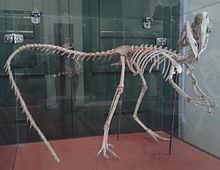|
Santanaraptor
Santanaraptor (meaning "Santana Formation thief") is a genus of tyrannosauroid theropod dinosaur that lived in South America during the Early Cretaceous (late Aptian-early Albian), about 112 million years ago. DiscoveryThe type species is S. placidus, first described by Kellner in 1999.[1] The species epithet refers to Placido Cidade Nuvens, who founded the Museu de Paleontologia da Universidade Regional do Cariri. Description The holotype (MN 4802-V) is a juvenile partial skeleton consisting of three caudal vertebrae with chevrons, ischia, femora, tibia, fibula, pes, and soft tissue. The fossilized tissue includes a thin epidermis,[2] muscle fibers, and possibly blood vessels.[3] Skin impressions under the left foot are also preserved, showing scales.[2] It was unearthed in 1996 from the Romualdo Formation (Santana Group) in the Ceará State, northeastern Brazil.[4] While primarily known from hindquarter elements, the individual represented by the fossil may have reached 1.5 metres (4.9 ft) in length and 15 kilograms (33 lb) in mass.[5] The fossil consists of bones from the pelvis, hindlimbs, and tail. These provide little information on its overall appearance. However, it was definitely a coelurosaur, and a few of its details suggest that it might be a member of the tyrannosauroids. It is presumed to be similar to Dilong and Guanlong in that it had long arms, three fingered hands, and slim hindlimbs.[4] Classification Santanaraptor was originally thought to be a maniraptoran theropod when it was first discovered. However, it is now thought to be a basal coelurosaur based on several features present on the femur. Santanaraptor was tabulated by Holtz (2004) as the first tyrannosauroid known from Gondwana,[6] a position also found by Delcourt and Grillo (2018).[7] However, this position has been criticised, as the supposed tyrannosauroid characters are widely distributed in Coelurosauria, and several aspects of the foot are more similar to noasaurids.[8] External linksSee alsoReferences
|
||||||||||||||||||||||||||||















